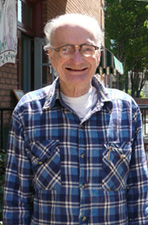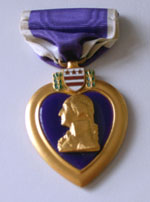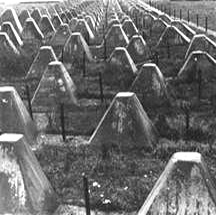Veterans' Stories – Richard C. |
Lamb is proud to be home or work for at least 20 veterans, including World War II veteran
Richard C.Richard C. now 88, was drafted into the Army from his hometown Willow Grove in 1942 at age 22. He says he wasn't too upset about serving, because his friends were doing the same thing. But his mother was apprehensive. “Mothers always feel bad when you go,” he says. “But the worst part is when the officers come and knock on your door at midnight.”
That knock on the door came shortly after D-Day in 1944, when Corporal Richard C. was shot by a sniper while working through
the Ziegfried Line, Hitler's last stronghold protecting Germany.
A Purple Heart
As a rifleman armed with a semi-automatic M1 Garand, Richard said he turned to see a sniper behind a tree. “My bullet hit the tree, and his hit my shoulder,” Richard explained. “That knocked me down and I played dead. But he came back and shot each leg.” Half his company members (approximately 60 men) were killed in this battle, and Richard’s injuries earned him a Purple Heart.
In the same melee, Richard was in a foxhole, trying to sleep when night artillery landed inside, covering him and a partner with “½ ton of dirt.” One eardrum was permanently burst from an artillery shell; the second was so damaged that he eventually became fully deaf.
The Siegfried Line
Photo from THE SIEGFRIED LINE CAMPAIGN by Charles B. MacDonald, first published in 1963 by the Center of Military History, United States Army.
“Some who have written of World War II in Europe have dismissed the period between 11 September and 16 December 1944 with a paragraph or two. This has been their way of gaining space to tell of the whirlwind advances and more spectacular command decisions of other months. The fighting during September, October, November, and early December belonged to the small units and individual soldiers, the kind of warfare which is no less difficult and essential no matter how seldom it reaches the spectacular.” Charles B. MacDonald, preface to the Siegfried Line Campaign.
Richard recalls that the Germans worked to protect their position with anti-tank German 88 mm guns and their walls were so heavily fortified (with three-foot-thick poured reinforced concrete) that the U.S. military shot again and again without success. "I looked at (U.S. shots) hit the roof and bounce off like a golf ball," he said.
Richard's company did break through the walls, and then battled through rolls of barbed wire as much as 9 feet high. They finally broke through, but the work slowed them down to the point that individuals were an easy target.
As the enemy worked to regain the field, Richard was shot in the chest, hip, shoulder, and left side. According to custom, he was awarded the Purple Heart in the hospital by a 2nd Lieutenant with no special ceremony. The moment was grim, he says, because so many of his friends were also wounded or had been killed.
Tour of Hospitals
Richard spent the next 7-8 months in hospitals, from a field hospital in Belgium, to a general hospital in England staffed by American physicians, to a New York City hospital specializing in bone surgery. One bullet remains in his hip, because surgeons were afraid he’d lose his ability to walk if surgery were unsuccessful.
Once home in Willow Grove, the trucking company Richard had driven for, was out of business. As he recuperated from his wartime experience, he made friends nearby at the Willow Grove Diner. The owner gave him a part-time job peeling potatoes, then taught him to cook. After some time, he joined Willow Grove Cab Company, where he learned to get tips by showing people the sights around town.
Cooking for a New Life
After Richard tired of taxi life, he returned to cooking, working for various places around Spring House in Lower Gwynedd Township for 20 years, including 15 years at Silver Stream Nursing Home.
Richard made Lamb Foundation his home in 2000, long after his retirement. He is a friendly face and much-loved person who can speak easily to you if you write down your questions for him. But his life stories are history; says he’s truly retired now!
(As described in August 2007)
Thanks to Jim Smith, Lamb Foundation Sweet Repeats Manager who helped us with interviews for this piece.
Note: Jim Smith is collecting stories from other vets now, and plans to form a group for them to share experience. Jim is also a veteran, having served from 1964 to 1970 in Europe and Southeast Asia for Army Global Operations in Strategic Communication Command.
"Anyone who served in WWII, are most proud, but their stories are the most sobering, because the destruction was so overwhelming," Jim says.
Look for more stories of War Veterans living at Lamb in upcoming eNews and the Lamb Foundation newsletter, Ewes News.


